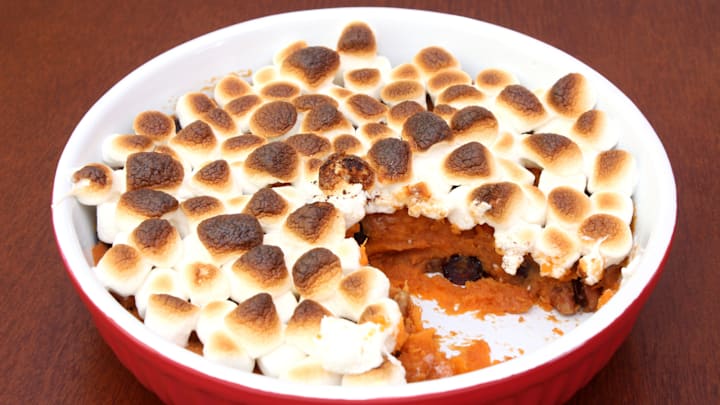Thanksgiving dinner has strayed far from the 1621 feast it’s meant to emulate. Today’s menu typically includes processed ingredients invented in the 20th century, like canned cranberry sauce, boxed stuffing, and condensed cream of mushroom soup (in the form of green bean casserole, of course). The most baffling “modern” dish served at Thanksgiving may be sweet potato casserole topped with gooey mini marshmallows. Despite what your grandmother says, this cloying side dish didn’t originate as a family recipe. It was concocted by Big Marshmallow as a way to push the candy on Americans.
Though the tubers are high in sugar to begin with, there’s historical precedent for treating sweet potatoes like dessert. According to The Kitchn, Amelia Simmons’s 1796 cookbook American Cookery features a recipe for “potato pudding” that calls for mixing one pound of boiled potatoes with half a pound of sugar. A century later in 1896, the first edition of the Boston Cooking School Cookbook published a recipe for glazed or candied sweet potatoes.
We know that sweetening already-sweet potatoes was an acceptable culinary practice by the turn of the 20th century, but serving the ingredient with literal candy was still unheard of. That changed in 1917, when Angelus Marshmallow came up with a bold way to promote its product. Prior to this, the marshmallow plant was primarily used to make medicine or luxury confections. Angelus was the first company to mass-produce the squishy white treats we now think of as marshmallows.
To get people on board with the new food item, Angelus’s marketing team sought help from Janet McKenzie Hill, founder of the Boston Cooking School Magazine. They hired her to develop a booklet of recipes highlighting marshmallows as the starring ingredient, thus showing American consumers how to use the product in their everyday lives. The most influential of these recipes was for “mashed sweet potatoes baked with a marshmallow topping.” According to Saveur, it’s the earliest known instance of a marshmallow-topped sweet potato recipe in print.
Sweet potato casserole was borne from a corporate marketing campaign rather than a home kitchen, but that doesn’t automatically make it inauthentic. Generations of home cooks have been making the dish their own for over a century. The Angelus recipe predates the Girl Scouts’ recipe for s’mores by nearly a decade, which means casserole is technically the more traditional marshmallow preparation. Just be prepared to enter a sugar coma if you follow it with a couple of slices of pumpkin pie on Thanksgiving.
